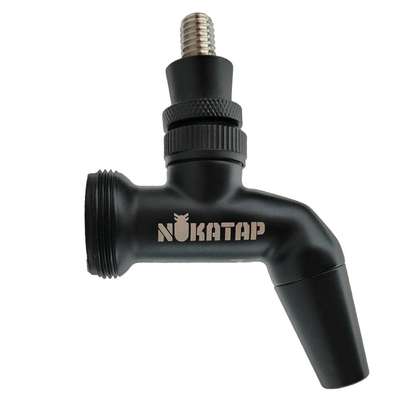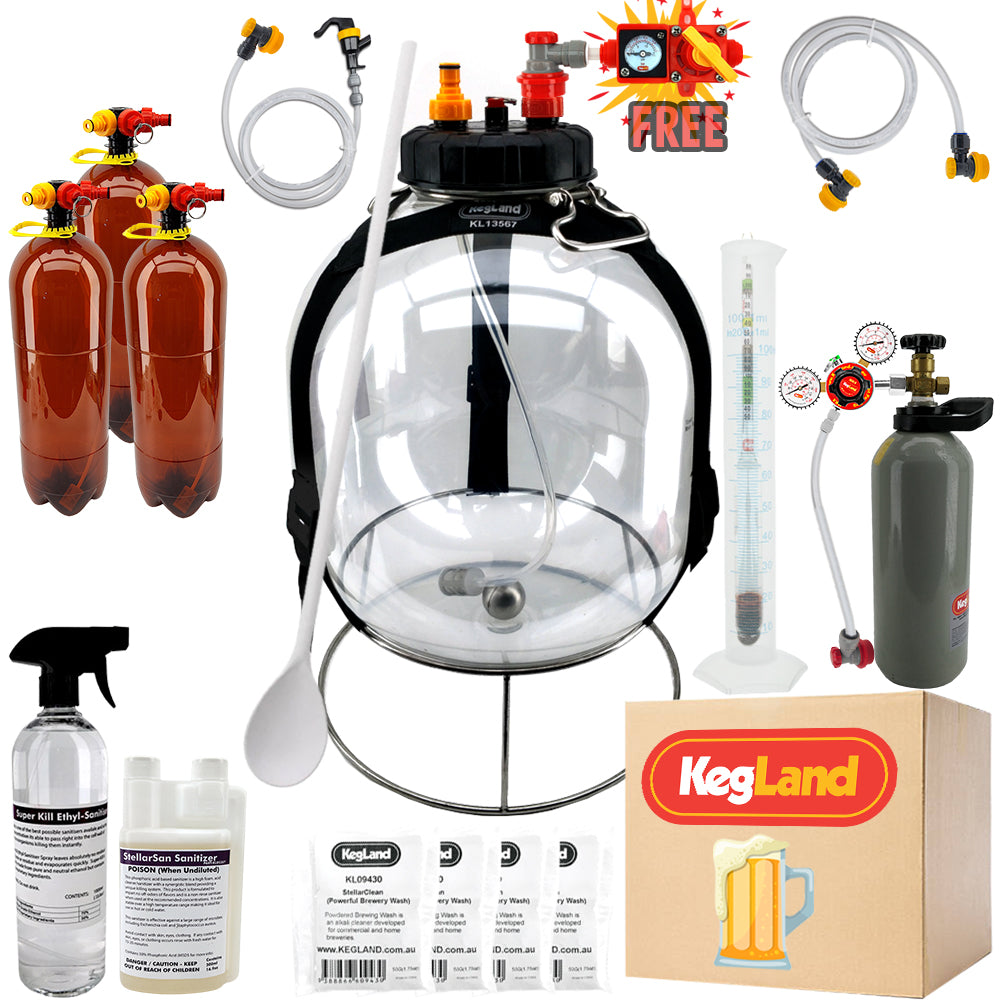Homebrewers tend to fall into two camps. Those who brew extract, and those who brew all grain. All Grain brewing is pretty widely considered to be an upgrade path from extract brewing – it was for me!
But there is no reason whatsoever, if you are an aspiring brewer, that you cannot just jump straight in and get your feet wet in the holy grail off All grain brewing. We are here to break it down , make it simple and bust the mystique!
What Is All Grain Brewing Anyway?
Beer is made from wort. Wort is the sweet liquor produced from malted grains after a process called mashing. Extract brewers are simply making beer with wort that has already been made. It is definitely possible with extract brewing to make great and even award winning beers.
But if you want to tailor your beers to suit your palate, or nail down a particular style, then All Grain is the way to go.
This is because there are many variables that determine the wort. With extract brewing you only have limited control in this. With All Grain brewing then you can very easily dial in a beer in ways that are simply not possible with extract.
All grain brewing is basically taking milled, malted grains and mashing them.
Mashing is, at the core, extremely simple. Essentially we just need to soak milled, malted grains in water at a set temperature for a set amount of time. This process will release enzymes from the malt that will break down and release the sugars in the malt. The end result is the sweet liquor known as wort.
Once made, this wort needs to be boiled to pasteurize and to break down and release chemicals and proteins.
That’s it! You now have made wort and a ready to ferment.
The Mash
Let’s look at the mash process in a bit more detail, as this is where you can really start to alter the flavours of your wort and thus your beer.
The main flavours will come from your choice of malts. It’s a great idea to use a tried and true recipe to get started, until you have the confidence to develop your own beer recipes. These All grain Recipe Kits are a great way to go, actually – tried and true recipes with step by step instructions.
Controlling the water chemistry and pH of the wort during the mash can also make a significant difference to the finished beer. It is absolutely not necessary, but if you are really wanting to nail down a style this is often the final frontier. Certainly when I started brewing NEIPAs, getting the water chemistry right was pretty much the last piece of the puzzle in producing a great beer.
We have a pretty comprehensive guide to water chemistry here – it is big enough to be a topic all on its own. If you do nothing else, grabbing some Phosphoric Acid and a pH Pen will help dial in the pH of the mash which in turn will increase your efficiency and help produce better beer.
The mash temperature plays a big role. Broadly speaking, you can mash every grain bill at 65°C for 60 minutes and produce great beer, but understanding how temperature plays a role will help a lot.
Generally, the higher the temperature of the mash, the less fermentable the final wort will be. Basically, the types of sugars that are broken down will change as the temperature of the mash rises. Higher temperatures produce more complex sugars, which are typically less digestible by yeast.
The temperature range for most mashes will generally be in the 63°C to 69°C range. 65-66°C would be considered the default range for the majority of beer styles. Mashing lower will produce a more fermentable wort with less body as a result. Mashing higher will produce more long chain sugars leading to a less fermentable wort with more body and mouthfeel.
Thus, if you mash the same grain bill at 64° and at69°C, you will produce quite different beers. The lower temperature mash will ferment more, so it will finish stronger and drier. The higher temperature wort will be less fermentable, so it will not have as high an ABV, but it will be fuller bodied as a result.
This is actually a quite complex and detailed subject, with step mashing and decoction mashing being just two more advanced techniques. Again though - you don’t need to be an expert – 65°C for 60 minutes will be fine for most beer styles. Feel free to delve deeper when you are more confident though!
So, to recap – mashing is simply soaking milled grains in hot water to convert the sugars. You can use a ‘mash tun’ – simply any heat proof vessel that will hold the grains and water and maintain temperature, or an all in one brewery like the BrewZilla.
The Sparge
Oh, sparging. So many words have been written. So many different sparging techniques. So much online disagreement about this.
Sparging is… rinsing.
Drain the wort into your kettle. Rinse the grains with hot (75°C) water to rinse the remaining sugars from the grain and hit your final pre-boil volume.
That’s it. Sparging done.
If you are running an all in one brewery such as a BrewZilla, then lift the malt pipe to drain the wort into the boiler, and slowly pour your preheated sparge water into the malt pipe. We include a perforated top screen to help get an even coverage and flow rate – it really couldn’t be much easier!
You need to ensure that the temperature of your sparge water is not too high, as this can lead to tannins being extracted which can cause an unpleasant astringency in the finished wort. Conversely, too low a temperature can lead to lower efficiency as less sugars will be extracted during the sparge.
The Boil
The boil is pretty simple. Once the wort is drained (lautered) into your kettle and sparged, increase the elements to full until the wort starts boiling. Typically you will boil for 60 minutes. Most beer recipes will have hop additions during the boil. These are to add bitterness (at the start or during the boil) or flavour (at the end of the boil or after flame out). Every half decent all grain recipe will have instructions on quantities and timing of the hops to get the right levels of bitterness.
During the boil you will see the ‘hot break’ form. These are basically clumps of proteins formed during the boil that are normal and nothing to worry about. Boiling also drives off DMS and the precursor, which is an off flavour reminiscent of creamed corn. Boiling also reduces the volume of the wort which increases the gravity (sugar content) and reduces the volume – these factors will be taken into account by most recipes and brewing software.
The process of boiling the wort will also darken the colour of the wort – some beers (such a English Barleywines) are essentially the result of a very long boil causing both deeper colour and complex, caramelized flavours from a long boil although the grain bill itself will be very simple.
Once the boil is done, simply transfer the wort into a hot cube for No Chill brewing, or chill it and transfer directly into your fermenter. The BrewZilla range has a built in pump for easy transfers, and also includes an immersion chiller to allow you to quickly chill the hot wort before transferring.
Now, this is all well and good, but what, I hear you ask, is the easiest way to actually start making All Grain beers for yourself, at home.
There are two main options.
One is BIAB, which is widely regarded as a cheap and easy way to get started in All Grain. It doesn't really have dedicated gear, so you do need to do a bit of research and get or modify equipment that suits what you have. You will most likely need a gas burner or similar as well, as the setup is typically too large for a domestic cooktiop to handle.
Thus, we recommend (and designed with you in mind) the BrewZilla range.
A BrewZilla is an All In One Brewery. This type of brewery started out as a boiler converted for brewing, but the BrewZillas are designed from the ground up for the purposes of brewing.
The main components are a thermostat controlled boiler, with a malt pipe and a pump for recirculation and transfers.
How does it all work, I hear you ask? Lets tackle this, by illustrating how to brew with a BrewZilla from start to finsh
How To Brew On A Brewzilla
First fill the BrewZilla with strike water - this is the water you will be mashing in. Set the thermostat to a few degrees higher than the mash temperature, to allow for temperature loss when the grain is added. Add brewing salts if you are using them - see this article for an in depth guide to brewing salts.
While the strike water is heating, mill your grains if they are not premilled. Grain mills allow you to order grain in bulk and brew whenever you want. Grain mills are pretty inexpensive so it is a great addition if you are a dedicated brewer.
The milled grains should be crushed well enough to allow for the mash water to penetrate to the core of each grain, but not so fine as to just be flour.

Once the water has reached the desired temperature, slowly add the grains to the malt pipe and stir super thoroughly. It is quite important to make sure you break up any dough balls that form so that the mash water can reach every grain.
One you are 'doughed in', start your timer and check your mash temperature. Mostly this will be around 65°C to 67°C, but some recipes may call for different temperatures. Test and adjust the mash temperature as needed.
Generally, most beers are mashed for 60 minutes, but this can differ - check your recipe.
On the BrewZilla, after around 10 minutes we want to slowly start to recirculate. Direct the pump tubing to the top of the grain bed (with or without the top screen, although most brewers will use it). Slowly, using the ball valve to adjust the speed, start recirculating the wort. Aim for a flow rate that keeps clear wort on top of the grain bed but with no danger of overflowing.
Recirculation helps to maintaon an even temperature in the malt pipe. it also allows the grain bed to act as a 'filter' so that when transferring the wort you can transfer a clearer product. It can also improve your efficiency.
After 60 minutes (or the time as per your recipe) it is time to lauter.
Lautering is simply the process of transferring clear wort into the kettle. In a BrewZilla this is literally as simple as lifting the malt pipe to the highest point of the boiler, where it will happily sit on the included ring. Your wort will drain directly into the boiler.
Note that you can save a decent whack of time by turning the elements onto Full (set them to HH on a Gen 3.1.1 BrewZilla) as soon as the malt pipe is raised. Thus, by the time the wort is lautered and sparged you may well be just about boiling.
Once the wort is fully drained into the boiler, begin sparging. You want your sparge water at between 75°C to 80°C, ideally. Slowly add the sparge water into the top of the malt pipe to rinse the last of the sugary goodness into the boiler. Adding the sparge water such that you keep an inch or two of sparge water above the grain bed at all times is best practice. This will also increase the volume of wort to your pre-boil volume.
When the wort has reached a boil it is time to start a timer so you can keep track. Typically you would also add your boil hop additions now. The boil hops provide most or all of the bitterness of the finished beer - your recipe will tell you how much to use and how long to boil for. the longer the hops are boiled for, the more bitter the beer will be.
Keep a close eye on the wort as the boil begins - this is when you will experience boilovers. if you continue to run the pump then this will help minimise the risk of a boilover at the start of the boil. You will notice, especially at the start of the boil, a whole bunch of wahat looks like clumps of protein float to the surace - it can in fact look quite nasty. Fear not! This is the 'hot break' and it is not only normal but expected and indeed quite necessary.
Once the boil is done, you are ready to transfer the wort.
Turn all elements off. If transferring the wort to an HDPE Cube for No Chill brewing, simply pump the wort directly into the cube. As long as the cube is clean, the boiling wort is more than hot enough to sanitise the cube as it fills. You then simply wait until the contents of the cube are cool enough to transfer to a fermenter - you can throw it in the pool to speed this up, if you like!
If you are chilling the wort with the supplied immersion chiller, you need to place the immersion chiller in the boiling wort 10 minutes before the boil is done. Thi is to ensure that the chiller is sanitised. When the elements are switched off at the end of the boil, begin circulating the water through the immersion chiller until the desired temeprature is reached. You can then use either the pump or the ball valve to transfer the wort to your fermenter.
Pro tip: If you keep the pump running and constantly stir or agitate the wort while chilling you will speed up the process by a significant amount.
That’s it! Your brewday is done (bar the clean up) and you are ready for the next step – fermentation. Where the magic happens.



